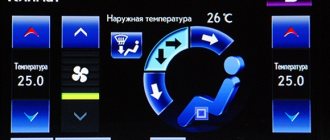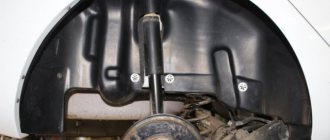Compare Lada and Volkswagen... Just a couple of years ago, only a crazy person could have thought of this. After all, if Volkswagen now is Touareg and Phaeton, then Lada, just like ten years ago, is nothing more than Priora or Kalina. What kind of comparison is there? And only with the appearance of the Lada Vesta, comparison with the “people's” German car does not seem like something unrealistic. Naturally, the new product from AvtoVAZ is not going to compete with the Phaeton, Passat and even Jetta sedans, but it can take away some buyers from the Volkswagen Polo. Or is trying to compete with Polo just a dream? After all, whatever one may say, the German sedan is the clear leader in its class and it will be very difficult to stand on the same level with it. Well, Lada Vesta, as we already know, is not a timid one.
Volkswagen cars are often criticized for the fact that their design is too similar to each other. And indeed, not everyone can often distinguish a Passat from a Jetta from a hundred meters away. And if for owners of fairly expensive middle-class sedans this fact is rather a disadvantage, then owners of an affordable Volkswagen Polo will regard this similarity as one of the biggest advantages of the car. Of course, you paid for a Polo, and those around you, although not everyone, will see you as the owner of a much more expensive car. And even if you don’t take into account that the Polo is almost a Phaeton in miniature, the appearance of the most affordable sedan from Volkswagen is still good. It is strict, precise and will not soon seem outdated.
The Lada Vesta sedan, unfortunately, has no one to follow as an example - the dozen models produced by AvtoVAZ do not have their own corporate style. But everything is going to the point that he will appear very soon. And Vesta will become its founder. We can only guess how the branded X-face will look on other models, but it suits the Vesta sedan very well. It’s not for nothing that everyone turns around after the VAZ sedan. Volkswagen Polo could not have dreamed of such attention even at the time of its debut.
The German sedan generally tries not to stand out. But this is exactly the case when modesty not only decorates, but also allows you to clearly demonstrate the true class of the car. Take a look at the interior of the Polo - at first glance there is nothing unusual, but after the first test drive you will understand that everything inside has been worked out just perfectly. If the driver's seat in the Lada Vesta is very good and definitely better than those installed in the Renault Logan or Hyundai Solaris, then in the Volkswagen Polo it is absolutely excellent. The widest ranges of adjustments and a verified profile are the standard. And in all other respects, Volkswagen is the same. All budget sedans are equipped with an automatic closer only on the driver's side window, but the Polo has them on the windows of all doors. It seems like a small thing, but it’s these little things that create the feeling of a high-quality, expensive car.
Not to say that compared to the German sedan, the Lada Vesta seems like such a simpleton, but in some ways the domestic car really does not reach the standard “German”. The interior plastic in the Vesta does not look so expensive, and the force on the buttons and levers, which seemed so calibrated compared to the Logan or Solaris, is now perceived as simply not bad. The Volkswagen Polo scores another point thanks to the steering wheel, trimmed in soft leather and beveled at the bottom. Vesta can only dream of such beauty for now. But just for now. Don’t forget that just last year, Polo, as if preparing for the appearance of Lada Vesta on the market, was updated twice. If we rewind time at least a year ago (or three or four years ahead, when Vesta is updated), then the picture could be completely different.
However, this does not apply to the second row of seats. No matter how much designers and engineers work to improve their creations, none of them can increase the wheelbase. The Volkswagen Polo is about eight centimeters smaller than the Lada Vesta, but the German sedan does not seem cramped at all. Moreover, sitting in the back in Polo is no less comfortable than in Vesta. And in terms of free space above the head, the German car actually outperforms the Vesta. But in a domestic car, three passengers in the back will be more comfortable. The transmission tunnel in Lada is below. And the front seat slides in Vesta do not interfere so much with the legs of the middle passenger.
We recommend: The best SUVs under 800 thousand rubles in 2019
Neither car has an overwhelming advantage when evaluating luggage racks. Each of them pleases with a low loading height and a wide opening, and at the same time offers a very respectable volume by the standards of the class - 460 liters for the Volkswagen Polo and 480 liters for the Lada Vesta. One cannot help but praise Vesta and Polo for the fact that each of them has a full-size spare wheel in the underground trunk. In our conditions, this is not a luxury at all, but a conscious necessity.
After a recent update, Volkswagen began offering new power units . From now on, the base engine for the German sedan is a 90-horsepower 1.6-liter gasoline unit. Although cars with the same volume, but already producing 110 “horses,” will certainly be in great demand. It can also be paired not only with a manual gearbox, but also with a six-speed automatic, which is much more preferable in urban conditions. But for the Lada Vesta, under the hood of which so far you can only see a 1.6-liter engine with a capacity of 106 horsepower, an automatic transmission is not offered and is unlikely to be offered in the near future. The role of the “automatic” on the domestic sedan should be played by the “robot” AMT. And looking ahead, we can say that the robotic gearbox copes with this role with a C grade. In terms of logic and smoothness of switching, the “robot” does not reach classic automatic gearboxes.
The Lada Vesta falls just short of its German competitor in terms of driving performance. The domestic sedan handles great, but the Volkswagen Polo does it a little better. On the straights it is very stable, and in corners the Polo turns into a reckless, but at the same time absolutely predictable car. And Polo is quieter. And again, everything could have been different if Vesta had to be compared with the pre-restyling Polo, which managed to receive a lot of criticism precisely because the engine was too noisy and, in general, not the most outstanding sound insulation. Now everything is different - even the quiet Vesta is somewhat lost against the background of the Polo.
Lada Vesta failed to win over Volkswagen Polo. The German sedan is a little better in almost every way. But there is no talk about the defeat of Vesta. Against such a strong opponent, who has also already managed to be updated several times, the domestic sedan performed very well. And after Vesta acquires new engines, the fight will be almost equal. Don’t forget that Lada Vesta is cheaper than its opponent. This is really “Try to ransom your Bride.”
General view and body parameters
He is a German and a German in Africa! The prestige of Volkswagen has always been undeniable. The long history of the famous brand, the recognizable logo on the hood, the names of the cars are heard by every second person in the world - at a time when Vesta is only at the beginning of the path that the German took many years ago on this path, it is quite confident, which pleasantly surprises its fans. They are still very far from reaching the heights of Volkswagen, but if you disassemble not the whole concern, but their individual products, the question immediately arises: “is their favorite Polo worth the money?”
In terms of bodies, the sides are equal - the sedan is the only body type presented in both models. However, the Lada Vesta has a chance to significantly tighten the screws on its competitor, because AvtoVAZ marketers claim that a car with such bodies as a hatchback and station wagon will soon be released.
A comparison of two cars, Lada Vesta and Volkswagen Polo, showed that Lada is superior to its rival in some technical parameters of the body.
The wheelbase of the Russian car exceeds that of the German one, which affects such an important point as space in the cabin. Vesta outperformed Volkswagen Polo by 82 mm in wheelbase width.
Lada Vesta or Volkswagen Polo? Body dimensions, wheelbase and ground clearance
The dimensions of Lada Vesta cars
are superior to their opponents in almost all characteristics.
- The length of the Volkswagen Polo is 4 m 39 cm, the competitor from Russia is 4 m 41 cm.
- The body width of the Lada Vesta sedan is 1764 mm, the “German” is 1700 mm.
- The height of the car from Togliatti is 1 m 50 cm, the opponent’s is 1 m 47 cm.
- The ground clearance of the Volkswagen Polo is determined by the figure 163 mm, while the competitor shows 178.
- The luggage compartment of the Lada Vesta can accommodate 480 liters of cargo, while the trunk of the German model only holds 460 liters.
- The wheelbase of the Volkswagen Polo is 2 m 64 cm, the new product from AvtoVAZ is 2 m 55 cm.
- The mass of the Lada Vesta is 1230 kg, the “German” shows 1163 kg on the scales.
Appearance of Lada Vesta and Volkswagen Polo
Regarding appearance, the cars here are completely different. Lada Vesta turned out to be muscular and aggressive. The front end resembles the forehead of a wrestler, the X-shaped chrome parts cross like hockey sticks, the powerful air intake is comparable to the mask of an American football defender, the anger inherent in the design of the headlights is reminiscent of the look of a mixed martial arts fighter, all these factors make the car a dangerous opponent on the road.
The rear of the car does not lag behind in style - the lights, expressing the general, strict appearance of the car, the confidence-inspiring bumper, with a dark edging and light deflector, as well as the badge with the name of the car - LADA - guarantee that Vesta will always attract attention and will be, without a doubt, find out.
Volkswagen is the absolute opposite. The well-known templates of the automaker made their way to the Polo, making it a smaller copy of its brothers. A lot of details in the appearance were transferred from the Passat - the smooth structure of the grille radiators and straight lines in the air intake, impressive optics, rectangular foglights turn the car into a respectable gentleman.
All gaps and joints are adjusted down to the millimeter, the quality of assembly from year to year confirms the skill of people working in Germany. The rims do not sparkle with design ideas, but they miraculously complement the strict and consistent style of the model. Taillights, classic curves of the trunk lid and bumper emphasize a unique and unlike anything else style. Volkswagen Polo owners will not be able to drive it, but everyone will receive satisfaction from comfortable driving.
Dimensions
Let's move away from aesthetics and Feng Shui. Let's talk a little about specific numbers. They will give us specifics about the advantages of one brand over another.
| Brand | Length, millimeters | Wheelbase, mm | Width, millimeters | Ground clearance, millimeters | Trunk, liters |
| Lada Vesta | 4 410 | 2 635 | 1 764 | 171 | 480 |
| Volkswagen Polo | 4 384 | 2 552 | 1 699 | 170 | 460 |
Surprisingly, Vesta is again the leader in all respects. The ground clearance is practically no different from the Polo. Otherwise, the Lada is longer and wider than its competitor. Another plus in favor of the domestic brand.
Engine performance and fuel consumption
In terms of engine ratio, the leading position is on the side of the German competitor. But the future lies with the Russian model. Today Polo is in the lead because in its showrooms it presents configurations with two different engines, while Vesta is represented by only one engine. Soon the situation may begin to change in the direction of the Russian auto industry, because it is planned to release models with a more powerful engine, thereby expanding the Lada Vesta's ability to be a competitive unit.
Recommended article: Rumors about the unreliability of the new gas tank of the restyled UAZ Patriot have been dispelled experimentally
Today the heart of the Lada Vesta is a 106 hp engine. With. Classic unit - 4 cylinders, 16 valves. Running distance of 106 l. With. carried out at 5,800 rpm. These characteristics enable Vesta to reach a hundred in 11.5 seconds and reach a top speed of 177 km/h. Consumption in urban conditions is stated at 9.2 liters, on the highway 5.4 liters, and combined cycle 6.8 liters.
The VAZ engine competes with the German 1.6-liter engine with sixteen valves. The figures are lower than the Russian equivalent - 87 liters. With. at 5100 rpm, but the torque is much higher. Polo is not at all embarrassed by lower performance compared to its Russian rival, because with less power, but correct tuning, the German manages to show results equal to Vesta - 11.9 s, up to 100 km/h, top speed 179 km/h. And Volkswagen Polo tried very hard with the consumption, because the output is significantly less than that of the Lada - city 8.7 l, highway 6.4 l, combined cycle 5.1 l.
Volkswagen Polo has another trump card in the form of a 1.6 liter engine, with special electronic settings, which produce much more power than its brother - 105 hp. With. at 5,600 rpm.
Such a unit accelerates a whole second faster - in 10.5 seconds, up to 100 km/h, and it will be crazy to squeeze out of the car, for this class 190 km/h. And the highlight of all this stuffing is the same fuel consumption as a regular 1.6 liter engine.
It is obvious that the Lada Vesta is inferior to the Volkswagen Polo in terms of engine equipment. True, Auto VAZ promises to soon begin producing Vesta with three more different engines, so the superiority of the German sedan is most likely a temporary phenomenon. A budget option, which will have the task of significantly reducing the cost of the car, will be an 87-horsepower gasoline engine. Another gift for Lada Vesta will be an engine from Avtovaz’s foreign assistants. Their brainchild produces 118 hp. s., but they plan to adapt it to Russian conditions and reduce the power to 112 hp. With. And the star of the entire line will be a 1.8-liter engine, the potential of which will be 121 hp. With. This engine is already installed in the Lada X-Ray, but in the fall of this year the installation of the unit will begin on the Lada Vesta.
Based on the results of this comparison, it undoubtedly turns out that the leader in the engine compartment is the Volkswagen Polo, but in the future, in about six months, the Lada Vesta has a chance not only to equalize positions, but also to come out ahead.
Motors
In the table below you can see a comparison of engines offered by the manufacturer for motorists.
| Vesta | Vs | Polo (sedan) |
| VAZ-21129: 106hp | VW 1.6 – 85 hp | |
| VAZ-21179: 122hp | VW 1.6 – 110 hp | |
| HR16DE: 110hp |
We recommend: Cars with permanent all-wheel drive: off-road or on hardwood floors?
Note that the internal combustion engine from the German concern installed in the Polo has the same displacement (1.6 l), but there are still some differences:
The first modification from the table has 85 hp. at good speed parameters. A car with such an engine accelerates to hundreds in 11.9 seconds. The maximum speed of such a car is 179 km/h.
The second internal combustion engine already contains 110 “horses”. Acceleration time to 100 km/h is 10.5 seconds. The highest achievable speed of this modification is 190 km/h.
The domestic manufacturer offers its customers three modifications of engines with 106, 110 and 122 hp, respectively:
The 1.6L has the lowest-power Vesta engine. A car equipped with such an engine accelerates to hundreds in 12.4 seconds, and the maximum speed of such a car is 178 km/h.
The next unit has 110 “horses” under the hood and allows it to accelerate to 100 km/h in 10.3 seconds. The highest speed achieved is 170 km/h.
The engine with the most powerful efficiency installed in the Russian new product already contains 1.8 liters, has a maximum speed of 185 km/h and allows acceleration to 100 km/h in 10.9 seconds.
Now let's look at the fuel consumption table for both cars:
| Model | Consumption | ||
| City | Mix | Route | |
| Vesta 1.6l-1.8l (106-122 hp) | 8.5l-8.6l | 6.8l-7.2l | 5.7l-5.9l |
| Polo 1.6l (85-110 hp) | 7l-7.6 l | 5.5l-6l | 5l -5.5 l |
Gasoline consumption for both cars is almost identical, with some advantage for the Volkswagen Polo. Also, the domestic new product is a little slower than the German representative, although Vesta’s internal combustion engines have more power.
What gearboxes are installed on Polo and Vesta
Both automakers made sure that their models were equipped with both manual and automatic transmissions. Mechanical enthusiasts on the Lada Vesta will receive a 5-speed gearbox, which was borrowed from the Priora. But in the process of creating the car, the old gearbox underwent many changes and improvements, and was equipped with the latest foreign parts - now Germany is responsible for the mechanical switching module, and Japan produces cable drives. All these factors and details helped us get a new gear shift system - now it has become much easier to shift, and the noise characteristic of old gearboxes is completely absent. The Vesta transmission can definitely be placed on the same level as the mechanics of imported manufacturers.
Recommended article: New Volkswagen Tiguan 2017
The Volkswagen Polo sedan puts a similar 5-speed manual transmission on the comparison scale. Volkswagen mechanics are a legend. The Volkswagen Polo manual transmission has all the properties of an impeccable transmission - short lever travel, smooth gear shifting and much more. Many car enthusiasts undoubtedly consider the transmissions of this car brand to be among the best in the world.
But the opponents’ machines are completely different. Lada Vesta is equipped with an AMT-type robotic transmission. And, of course, there are foreign components in the box. In general, the box copes with its function, works, switches, and creates the necessary conditions for ease of driving. AMT is quite far from the classic automatic transmission, it lacks the smoothness of gear shifting that everyone so wants to see in their automatic transmissions, but the VAZ gearbox is easier to operate and much cheaper, which significantly affects the overall price tag of the Lada Vesta car.
Polo has a 6-speed automatic transmission in its arsenal. There is no need to guess here, it surpasses Vesta’s AMT in all respects - clear and timely gear changes, ride comfort is higher, and the 6th gear takes care of your wallet, significantly reducing fuel consumption. But the price tag of a car with such an automatic transmission may surprise some people; the price is not small in comparison with its Russian competitor.
Who has more reliable engines and gearboxes?
VW Polo is equipped with two engines - 1.6 MPI with 90 and 110 hp. s., as well as 1.4 TSI with 125 “horses”. The MPI comes with a 5-speed manual or a six-speed automatic, while the TSI comes with a 6-speed manual or a seven-speed automatic. The advantages of MPI are practicality and reliability. It does not overheat and runs not only on the recommended 95, but also on 92 gasoline. TSI is more powerful and more economical, but does not heat well in the cold season.
Lada Vesta is sold with 1.6 and 1.8 engines with 106 or 122 hp. With. They are equipped with mechanics (can be either VAZ or French Renault) or a Russian-developed robotic gearbox (VAZ-21827). 1.6 - dynamic, high-torque and silent, but prone to overheating and oil consumption. The 1.8-liter engine has moderate “appetites” and good acceleration dynamics. But it is also prone to eating oil, and the expansion tank and timing belt may break.
The lack of an honest, albeit outdated, automatic transmission is a big minus of the Lada Vesta. The robot slows down, pushes, and changes gears incorrectly. Not in Vesta's favor is higher fuel consumption. In the combined cycle, it consumes 6.6 liters per 100 km, while the Polo consumes 5.7-5.9 liters.
We recommend: The most stolen cars in Russia based on statistics
Car suspension and handling
Here AvtoVAZ and Volkswagen AG did not take risks and none of the models has a multi-link chassis. This decision was made to reduce the overall cost of cars. The car is equipped with parts familiar to this class - MacPherson struts at the front, semi-independent suspension at the rear.
Volkswagen Polo is considered to be an example of handling among sedans of this class. Lada Vesta was able to reach the level of the standard, but, without a doubt, it was not without a doubt; nevertheless, in some small details it loses to the German. The advantage of the Lada is its high ground clearance, while the disadvantage of the Volkswagen is the low location of the rear spring supports. The supports are strong, but when you hit an obstacle, a noticeable grinding noise causes discomfort.
Transmission
If we compare mechanical transmissions, then German gearboxes will definitely win. They have very comfortable gears and are short, making them easy to control. They are also highly reliable
. The boxes on the Lada Vesta are modified parts from Kalina. Engineers were able to slightly improve this unit. In particular, the problem with increased noise was eliminated.
It’s not entirely correct to compare automatic transmissions here. The Lada Vesta has a robotic gearbox, which was converted from a manual gearbox. It is quite easy to operate; compared to the mechanics of this model, manual transmission is less effective.
The Volkswagen Polo has
a 6 automatic transmission.
In comparison with
the manual transmission
, this option is more pleasant to work with. But automatic transmission is more demanding to maintain.
Interior of Lada Vesta and Volkswagen Polo
The designers are different, the manufacturing countries are different, and therefore the interior design is different. Vesta is made in a more sporty and aggressive style. The instrument panel has excellent indicators for speed, fuel, and revolutions, and the three-spoke steering wheel is similar to a racing steering wheel. The console in the center looks modern and not cheap. The torpedo is made of high-quality plastic, made in one tone, with metal inserts that fit neatly into the interior decoration and do not create a feeling of dissonance with the overall design idea of the interior.
The conveniences of the Lada Vesta are not satisfactory - the instruments can be read without problems, and the control units on the center console have free and easy access. One of the few little things that the driver may have to get used to for some time is the armrest combined with the seat. And by the way, Vesta’s chair itself has absolutely no shortcomings, is competently designed and performs its task, keeping the driver in the saddle, impeccably. Good visibility of the car is guaranteed by high-quality glass and a large area of this glazing.
There is a lot of free space for passengers in the rear seat, so that three passengers can move in the car over long and short distances without much discomfort. But there are complaints from tall people about the too low edge of the rear roof of the Lada Vesta.
Polo is designed for a comfortable ride and is the complete opposite of Vesta. Every detail, all the controls are well designed and installed in their places, everything is done in such a way that you can operate everything in the cabin with your eyes closed. There are no complaints about Volkswagen designers. A recognizable three-spoke steering wheel, an instrument console with buttons for controlling interior functions, dark-colored plastic, chrome, and a dashboard in the best traditions of the German auto brand, which is readable in a split second in any day or night light.
Recommended article: Audi Q5: before and after restyling. What's changed in the new Q5?
Visibility in the Volkswagen Polo is excellent, the seats are comfortable and made of quality materials. Due to the shorter wheelbase, the rear space is slightly less than that of the Vesta, but for two people the ride will be very comfortable. There are owners who consider the Polo's interior design to be a little callous and restrained, but the majority of Polo owners consider it ideal for this class of car.
Body
Externally, both cars look quite solid. In terms of external design, these are modern cars for city dwellers. But Lada Vesta has a more original and memorable design. In general, the Russian car is somewhat reminiscent of a sports model, which young drivers like.
An important indicator is the protection of the body from corrosion. In general, the domestic model has a thicker layer of paintwork, which indicates better protection. According to the observations of car owners, Vesta is not prone to chipping on the body. But with corrosion, not everything is so simple. The Germans have always been famous for their high-quality galvanized bodywork, and the Volkswagen Polo is no exception. Therefore, we can assume that there will be fewer problems with rust on a German car.
Both cars are comfortable inside
. The driver's seat has a sufficient number of settings. This makes the cars suitable for long trips. In this regard, it makes sense to choose according to your own feelings. Instruments in Vesta are located within reach, all readings are easy to read. The keys are large enough to be easily located both visually and by touch. At the same time, Volkswagen has always been famous for its intuitive controls. Polo has not changed this tradition either. According to reviews from owners, after 10-15 minutes you stop thinking about the location of control devices. The multimedia system works equally well in both versions. But many music lovers note that the German car's speakers are placed more efficiently.
If the size of the interior is important to you, then you are better off purchasing a Lada Vesta. It has significantly more space in the back row of seats. This will be convenient for young parents who install child restraint seats in their cars. It will be a little more difficult to place them in the Volkswagen Polo.
Both models use high-quality plastic for interior trim. It feels quite pleasant to the touch and looks quite good. But the build quality of the Volkswagen Polo is slightly higher, and no problems arise with it. In some cases, crickets are found on Lada Vesta, which seems to be an incurable disease of AvtoVAZ.
Compare prices and options
Lada Vesta is presented in 6 different versions - from Classic to Luxury Multimedia.
The basic configuration already pleases the buyer with a large number of options, especially with regard to safety. With Lada Vesta you won't be afraid to drive on dangerous sections of the road. The sedan is equipped with several airbags, as well as seat fastenings similar to ISOFIX models. Inside, the interior looks budget-friendly, but everything you need is at hand - this includes an audio system, a steering wheel with possible adjustment, electric front window lifts, adjustable side mirrors and an anti-fog system, and there is also an on-board computer. The basic configuration comes with stamped wheels. You will have to pay 515,000 rubles for this Vesta package.
You can buy a Volkswagen Polo in five trim levels – from Trendline to Highline.
The standard Polo package is about one hundred thousand more expensive than the Vesta version - 614,000 rubles. At the same time, the Polo is significantly inferior to the Lada in terms of safety parameters. Otherwise, the basic equipment of Volkswagen is the same as the Russian one - front windows with electric lifts, audio system. And one significant bonus is the air conditioning system.
Well, it is logical that along with the increase in price, the salons of Vesta and Polo are supplemented with more advanced options. So, in the maximum version, the Lada is priced at 634,000 rubles. It will have a climate system, a 7-inch touchscreen display with many useful functions, navigation, a full set of speakers throughout the cabin, parking sensors, 16-inch alloy wheels, turn signals on the side mirrors, maximum power accessories, heated front and rear windows, and much more. other useful functions.
The maximum configuration Volkswagen Polo boasts approximately the same set of options, with a navigator, alloy wheels, maximum power accessories and other features. And on top of that, the Polo will have the latest climate system. And the price tag will instantly increase and show the amount of 760,000 rubles, and with automatic transmission it will rise to 805,000 rubles! This is not counting the possibility of additional installation of various options from the list offered by the manufacturer, which will significantly increase the price.
Based on this comparison, it is clear that Polo and Vesta do not have fundamental differences in their configurations, not counting only one option that is available in Polo - air conditioning in the base version and a climate system in the maximum version. As for the price, the difference in price tags is very large. So, anyone who wants to get a sedan car from class B has something to think about. Should we definitely look towards the German? After all, the price of the basic configuration of the Volkswagen Polo is almost equal to the maximum configuration of the Lada Vesta.
You can also read on this topic:
Presentation of the new Mercedes-AMG GT4 super racing car
The new generation Kia Rio sedan “lit up” in the Middle Kingdom
Photos of the next generation Volkswagen Polo published on the Internet
Is it possible to buy a new car for up to 300,000 rubles?
Mercedes E Class from AMG impresses with its speed and power
Share on social networks
Dmitry Seregin August 5, 2017
Published in: German cars, Russian cars
Tags: Volkswagen, Our cars, German cars, Russian cars, sedans, Economical
Operational characteristics and completeness
In January 2020, an independent organization conducted a crash test of the Lada Vesta. For this purpose, a standard car was used in the comfort configuration with two front airbags. The tests were carried out using the ARCAP system. According to the test results, Vesta turned out to be safer than competitors such as Hyundai Solaris and Ford Focus, but it did not reach the level of Volkswagen Polo, although the gap is insignificant.
The new AvtoVAZ vehicle scored 14.1 points or 4 stars, while the Polo scored 14.3 points. The tests were carried out in a frontal collision at a speed of 64 km/h. It is worth noting that in parallel with this, an unplanned check of the ERA-GLONASS system was carried out, which recorded the accident, and the specialists had to explain to the employee that tests were being carried out with the participation of dummies.
Features of the packages
Lada Vesta has three main options, and taking into account additional options, there are six of them. As standard, the car has two front airbags, various assistants (from ABS to stability control), and there are mounts for child restraints. The interior decoration of the cabin cannot be called luxurious. But there is everything you need, including audio preparation, two-way adjustable steering wheel, front electric windows, heated seats and power side mirrors.
There is also an on-board computer built into the instrument cluster. On the outside, stamped steel wheels with a diameter of 15 inches can be noted. Depending on the configuration, an audio system, navigation, heated rear seats, alloy wheels, air conditioning, rain and light sensors, turn signal repeaters in the side mirrors, heated glass and many other options can be added.
Volkswagen Polo has a total of five trim levels. The basic one is called TrendLine, and the top one is called Highline. Even in the standard set, Polo is almost 100,000 rubles more expensive than Vesta, but it lags behind in terms of safety, but otherwise they are similar. With each subsequent model, the number of options increases proportionally.
Even in top trim levels, Lada and Polo are very similar. The only significant difference is that Vesta does not have a machine gun, but the German does.
Climate control is also available. But the price, accordingly, for the top-end configuration is higher than that of the Russian analogue.
CASCO
To calculate the average price of a CASCO policy for our cars, we used online calculators from five leading insurance companies included in the top ten of the Russian market. The insurance conditions are identical. The list of services includes the possibility of multiple replacement of glass elements, as well as the visit of an emergency commissioner. Repairs are carried out only at official dealer stations.
- a young unmarried girl aged 18 with zero driving experience; - a 32-year-old man with a family and children who has had a license for 14 years; - a 65-year-old man with 47 years of driving experience.
| Automobile | Car price, rub. | CASCO policy price, rub. (% of car price) | ||
| For a girl | for a middle aged man | for an elderly man | ||
| Lada Vesta | 750000 | 110778 (14,8%) | 51747 (6,9%) | 40450 (5,4%) |
| Hyundai Solaris | 750000 | 140305 (18,7%) | 68531 (9,1%) | 54423 (7,3%) |
| Kia Rio | 750000 | 134627 (18,0%) | 63728 (8,5%) | 50247 (6,7%) |
| Volkswagen Polo | 750000 | 139371 (18,6%) | 63649 (8,5%) | 46148 (6,2%) |
* Tariffs for Moscow according to the companies Ingosstrakh, RESO-Garantiya, Renaissance Insurance, MAX and Rosgosstrakh.
More about Solaris
- Test of budget sedans Ford Fiesta, VW Polo, Kia Rio and Renault Logan. Recertification
- Kia Rio, Hyundai Solaris or Volkswagen Polo - which is better?
- Automatic transmission, manual transmission for Hyundai Solaris: fuel consumption, reviews
- Cars of our time - Autoreview
- Let's check how the Kia Rio sedan has learned the lessons of Solaris. Test drive kia rio_dt - DRIVE
- Crash test Volkswagen Polo sedan
- Hyundai Solaris vs VW Polo Sedan: comparison, characteristics, photos
- Kia Rio, Hyundai Solaris or Volkswagen Polo - which is better?
- Which is better RIO, Polo or Solaris
- Which is better RIO, Polo or Solaris











